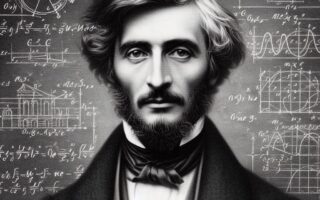Lagrange’s Impact on the History of Mathematics and Science
Joseph-Louis Lagrange (1736–1813) is widely regarded as one of the greatest mathematicians in history. He made groundbreaking contributions to various fields, including mechanics, algebra, calculus, and number theory. His work laid the foundations for much of modern mathematics and profoundly influenced subsequent generations of mathematicians and scientists. Lagrange’s ability to synthesize ideas from different branches of mathematics into a unified whole has left an enduring legacy, and his methods continue to shape the development of both pure and applied mathematics today.
Early Life and Education
Joseph-Louis Lagrange was born on January 25, 1736, in Turin, in what was then part of the Kingdom of Sardinia. His father was of French descent, and his mother was Italian. Originally, Lagrange’s family intended for him to pursue a career in law, but he became captivated by mathematics in his teenage years after reading the works of Edmond Halley and Isaac Newton. Lagrange was largely self-taught, immersing himself in the works of famous mathematicians such as Leonhard Euler and Pierre-Simon Laplace.
By the age of 19, Lagrange was already making significant contributions to mathematics, and he was appointed as a professor at the Royal Artillery School in Turin. His early work focused on the field of mechanics, particularly the development of the calculus of variations, a mathematical discipline concerned with finding the function that optimizes a given quantity. This early achievement would be the foundation for some of his most significant contributions to mathematics.
Contributions to Mechanics and the Lagrangian Formulation
One of Lagrange’s most profound contributions to science is his work in classical mechanics. He developed a new mathematical framework for understanding the motion of objects, known as Lagrangian mechanics, which is still widely used today in physics and engineering. In this framework, the motion of a system is described by the principle of least action, which states that the path taken by a system between two points is the one that minimizes the action, a quantity that depends on the kinetic and potential energy of the system.
In 1788, Lagrange published his famous work, Mécanique analytique (Analytical Mechanics), in which he reformulated Newtonian mechanics using calculus. Rather than relying on Newton’s laws of motion, which describe forces acting on objects, Lagrange’s method uses generalized coordinates and the concept of Lagrange multipliers to describe the motion of complex systems in a more elegant and general way.
The Lagrangian approach has several key advantages over Newton’s laws, particularly when dealing with systems that have constraints, such as a pendulum or the motion of planets. It provides a way to analyze the motion of a system without explicitly dealing with forces, which simplifies the mathematics considerably. Today, Lagrangian mechanics is fundamental to many areas of theoretical physics, including quantum mechanics, field theory, and the general theory of relativity.
Contributions to Calculus and Algebra
Lagrange made significant contributions to calculus, particularly in the field of differential equations and analytic functions. One of his most famous achievements in this area was his work on the theory of functions. He developed the Lagrange remainder in Taylor’s theorem, which provides a way to approximate functions using polynomials. This result is crucial in numerical analysis and has applications in various areas of mathematics and science, from computer simulations to financial modeling.
In algebra, Lagrange is perhaps best known for his work on polynomial equations. He laid the groundwork for what would later become Galois theory, a branch of algebra that studies the solutions of polynomial equations and their symmetries. Although it was Évariste Galois who ultimately developed the theory, Lagrange’s early insights were essential in understanding the structure of polynomial equations.
Lagrange’s Lagrange’s theorem in group theory, which states that the order of a subgroup of a finite group divides the order of the group, is a fundamental result in modern algebra. This theorem is central to the study of symmetries and has applications in areas as diverse as cryptography, quantum mechanics, and crystallography.
Contributions to Number Theory
Lagrange also made significant contributions to number theory, a branch of mathematics concerned with the properties of integers and their relationships. His work on quadratic forms, which are polynomials of degree two, helped lay the foundations for modern number theory. Lagrange’s four-square theorem is one of his most famous results in this field. It states that every positive integer can be written as the sum of four squares, an insight that has influenced later work in algebraic number theory.
Additionally, Lagrange made strides in the study of Diophantine equations, named after the ancient Greek mathematician Diophantus. These are polynomial equations where only integer solutions are sought. Lagrange’s work on these equations inspired later mathematicians, including Carl Friedrich Gauss, who built upon Lagrange’s methods to create modern algebraic number theory.
Contributions to Astronomy
Lagrange’s work extended beyond mathematics into astronomy and celestial mechanics. He made crucial contributions to the study of the motion of planets and the stability of the solar system. His work on the three-body problem, which concerns the motion of three celestial bodies under the influence of gravity, is particularly significant. Lagrange showed that there are certain points in the plane of orbit where a small object, such as a satellite, can remain stationary relative to two larger bodies, such as the Earth and the Moon. These points, known as Lagrange points, are now used by space agencies for placing satellites in stable orbits.
Lagrange’s work on perturbation theory in celestial mechanics also helped to explain the small deviations in the orbits of planets caused by the gravitational influence of other planets. His methods were later used by astronomers such as Laplace to study the long-term stability of the solar system, and they remain essential tools in modern astrophysics.
Influence on Modern Mathematics and Science
Joseph-Louis Lagrange’s impact on the history of mathematics and science cannot be overstated. His work laid the foundations for many branches of mathematics, including calculus, algebra, and number theory. His Lagrangian mechanics revolutionized the way physicists think about motion, and his contributions to celestial mechanics helped scientists understand the dynamics of the solar system.
One of Lagrange’s most enduring legacies is his emphasis on rigor and abstraction in mathematics. He sought to unify different areas of mathematics under a single framework and often focused on general methods rather than specific results. This approach had a profound influence on the development of pure mathematics, where the emphasis is on finding general principles and structures that can be applied across many different areas of mathematics and science.
Lagrange’s work also influenced the development of modern physics. His Lagrangian formulation of mechanics was later extended by the mathematician and physicist William Rowan Hamilton, whose work on Hamiltonian mechanics provided the mathematical framework for quantum mechanics and modern field theory. The principle of least action, which underlies Lagrangian mechanics, is a fundamental concept in many areas of theoretical physics, including classical mechanics, quantum mechanics, and general relativity.
Conclusion
Joseph-Louis Lagrange was a towering figure in the history of mathematics and science. His contributions to mechanics, calculus, algebra, number theory, and astronomy laid the groundwork for many of the mathematical and scientific advancements that followed. Lagrange’s ability to unify different areas of mathematics into a coherent whole, along with his emphasis on rigor and abstraction, has had a lasting impact on the development of both pure and applied mathematics.
His work continues to influence modern physics and engineering, and his methods are still used by scientists and mathematicians around the world. Whether in the study of planetary motion, the design of satellites, or the exploration of abstract mathematical structures, Lagrange’s legacy remains an integral part of the fabric of modern science.
Please Visit Our Sponsors:
We only support vendors that we use ourselves in our home. The links below are our own links or affiliate links but know that we use all of these now, or have in the past. As the author/creator of this blog, I also tutor mathematics on Wyzant, sell on Etsy, create content on TpT, and learn Korean on Rosetta Stone.





